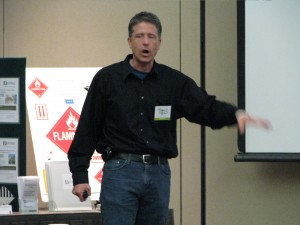Federal regulations of the U.S. Environmental Protection Agency (USEPA) at 40 CFR 262.17(a)(6) require a large quantity generator of hazardous waste (LQG) to comply with the preparedness, prevention, and emergency procedure standards of 40 CFR 262, subpart M. This article is the sixth in a series that looks closely at each of the sections in subpart M to clearly describe the responsibilities of a LQG.
The purpose of this article is to address the requirements of 40 CFR 262.255 Required aisle space.
Before we begin…
These regulations were revised by the Generator Improvements Rule. If your state has not yet adopted the new rule you must continue to comply with the earlier version until it does. You may read an article explaining the earlier version of the regulations (prior to implementation of the Generator Improvements Rule) here.
|
Not sure of your hazardous waste generator status? |
Scope and Applicability:
These regulations are applicable to a LQG. The requirements of a small quantity generator of hazardous waste (SQG) are almost exactly the same. If you are a SQG please refer to this article for your version of these regulations: Emergency Preparedness and Prevention for Small Quantity Generator: Required Aisle Space. (This article is not yet written. Once it is I will add a link to it here.)
As made clear by §262.250 (revised by the Generator Improvements Rule), the preparedness, prevention, and emergency procedures of Subpart M are applicable to those areas of a LQG where hazardous waste is generated or accumulated. This includes:
- Central Accumulation Area (CAA)
- Satellite Accumulation Area (SAA)
Read: Applicability of Preparedness, Prevention, and Emergency Procedures for LQG
40 CFR 262.255 reads:
The large quantity generator must maintain aisle space to allow the unobstructed movement of personnel, fire protection equipment, spill control equipment, and decontamination equipment to any area of facility operation in an emergency, unless aisle space is not needed for any of these purposes.
Why the change?
Not much of a change. The opening sentence was revised from, “The owner or operator…” in the original to, “The large quantity generator…” in the updated version. This reflects the fact that the preparedness, prevention, and emergency procedure regulations of 40 CFR 262, subpart M apply solely to a LQG.
|
Interested in a Webinar that covers this topic, and more! |
Required Aisle Space:
Virtually unchanged by the Generator Improvements Rule, subjective in its requirements, and easily overlooked. Don’t become lax! Compliance with this section of subpart M is very important.
Let’s take a closer look at the wording, terms, and phrases used in this section:
“…must maintain aisle space…” The requirement is not just to have aisles at the LQG but to maintain aisle space. An obstruction placed in an aisle – e.g., a pallet – could be a violation if the aisle space is lessened. Notice however, that no amount of aisle space to maintain is specified. Is it two feet? Three? More?
“…to allow the unobstructed movement…” Here is the first indication of a measure – though subjective – of what will be deemed as adequate to meet the requirements of this regulation. The aisle space must allow for the unobstructed movement of the following in an emergency:
- Personnel (presumably the employees of the LQG but may also include emergency response personnel).
- Fire protection equipment
- Spill control equipment
- Decontamination equipment
The equipment indicated are required at a LQG by 40 CFR 262.252(c).
|
Contact me with any questions you may have about the generation, identification, management, and disposal of hazardous waste Daniels Training Services, Inc. 815.821.1550 |
“…to any area of facility operation…” This is – by far – the most important text of this section and perhaps the most commonly overlooked. It is not sufficient to maintain aisle space solely within the central accumulation area (CAA), satellite accumulation area (SAA), or other area(s) of the LQG where hazardous waste is generated, accumulated, or treated. The requirement to maintain aisle space according to 40 CFR 262.255 applies to any area of facility operation where it may be necessary to respond in an emergency.
“…unless aisle space is not needed…” And, of course, there’s an allowance for the LQG to determine if aisle space is not needed in some or all areas of its facility, in which case aisle space need not be maintained.
|
Contact me the next time hazardous waste generator USEPA training is due to expire. |
Q: So, just so I’m clear, I must maintain at least three feet (36 inches) of aisle space, correct?
A: No. The regulations of USEPA do not specify a minimum distance for what it requires for aisle space in 40 CFR 262.255. However, a state with an authorized hazardous waste program can make its regulations more stringent and more broad than those of USEPA. A state, may specify a minimum distance to demonstrate compliance with this section.

A: No. The requirement to maintain aisle space applies to any area of facility operation where personnel or equipment may need access in an emergency.
Is that it?
No. First of all, as a LQG you must still comply with the remaining requirements of §262, subpart M as revised by the Generator Improvements Rule.
And then, what about training? At §262.17(b)(7) – directly following the referral to emergency procedures – are the training requirements for a LQG. §262.17(b)(7)(i)(C) reads in part:
At a minimum, the training program must be designed to ensure that facility personnel are able to respond effectively to emergencies…
So clearly, Hazardous Waste Personnel Training at a LQG is important.

